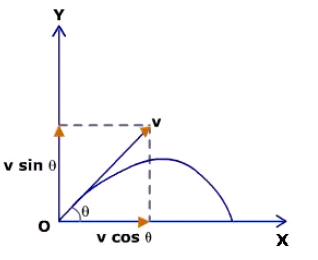A projectile is shot from the ground at an angle of #(5 pi)/12 # and a speed of #12 m/s#. Factoring in both horizontal and vertical movement, what will the projectile's distance from the starting point be when it reaches its maximum height?
1 Answer
Explanation:
As you know, a projectile launched from the ground at an angle

Vertically, the projectile will be acted upon by gravity. This means that its vertical movement can be broken down into two parts
- from ground level to maximum height**
- from maximum height to ground level**
On its way up, the projectile is decelerated by the gravitational acceleration,
The key here is to realize that at maximum height, the vertical component of its velocity will be equal to zero.
Horizontally, on the other hand, the projectile's motion in unaffected by gravity, or by any other force for that matter. This implies that the horizontal component of its velocity will be constant throughout its motion.
So, if we take
#v_(0v) = v_0 * sin(theta) -># the vertical component of its initial velocity
#v_(0h) = v_0 * cos(theta) -># the horizontal component of its initial velocity
Your strategy now will be to find the time needed for the projectile to reach maximum height, then use that time to calculate the horizontal distance it covered.
So, you know that at maximum height you have
#v_v = 0#
This means that you can write, for the vertical component of the projectile's motion,
#overbrace(v_v)^(color(purple)(=0)) = v_(0v) - g * t" "# , where
Rearrange to solve for
#t = v_(0v)/(g)#
Plug in your values to get
#t = (12color(red)(cancel(color(black)("m")))color(red)(cancel(color(black)("s"^(-1)))) * sin((5pi)/12))/(9.81 color(red)(cancel(color(black)("m")))"s"^color(red)(cancel(color(black)(-2)))) = "1.18 s"#
This means that you can write, for the horizontal component of the motion
#d = v_(oh) * t#
#d = 12 * cos((5pi)/12)"m" color(red)(cancel(color(black)("s"^(-1)))) * 1.18color(red)(cancel(color(black)("s"))) = color(green)("3.66 m")#

